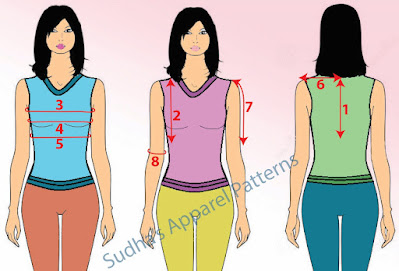Hello everyone,
I am back with one more pattern of saree blouse and this time it is a stylized Designer Blouse with Deep Neckline and Elbow length sleeves. This pattern was requested by one of the subscribers.
Fyi (in case you are new to little blog of mine☺), in my previous few posts, I have explained pattern making of some very common saree blouse patterns like Simple Sleeveless Blouse, Basic Saree Blouse with Sleeve, Double Katori Blouse, One Piece Katori Blouse and also a simple stylized Sun-rays Neckline Saree Blouse, Saree Blouse with Back Smocking, High Neck Saree Blouse, Stand "V" Saree Blouse, Raglan Sleeve Saree Blouse, Blouse with Basque (Patti), Boat Neck Saree Blouse and Scallop Shaped Neckline.
You can also visit my new YouTube Channel - "Sudha's Apparel Patterns" for more sewing videos. Please Subscribe the Channel if you like it.☺
So let's start with step-wise pattern making of yet another stylized Designer Blouse with Deep Neckline and Elbow length sleeves.
You can also visit my new YouTube Channel - "Sudha's Apparel Patterns" for more sewing videos. Please Subscribe the Channel if you like it.☺
So let's start with step-wise pattern making of yet another stylized Designer Blouse with Deep Neckline and Elbow length sleeves.
The Blouse pattern has (1) Elbow length Sleeves, (2) Deep neckline and (3) Front Basque. This blouse will have a back opening.
* The pictures and instructions are offered here for free. Please don't repost any of my content without permission. Thanks!
To make a stylized Designer Blouse with Deep Neckline and Elbow length sleeves, all measurements must be taken with great care for precise results.
Some Tip:- It is very important that you wear your best-fit undergarment (i.e. Bra) in order to get the most accurate measurements. If you think the bra is loose, adjust the straps accordingly, before taking blouse measurements.
2. Length of front - Measure from centre of front shoulder passing over
the bust point to 5 to 6 cms above waist line.
3. Round Chest - Take it by passing the tape measure around the body
under the armpits. Make sure that the tape at back is over the
shoulder blades, parallel to the ground and not loose or hanging at
the back.
4. Round Bust - Measure around the body at the fullest point of bust. Do
not allow the measuring tape to fall at the back. The tape should pass
on the most protruding part of the bust.
5. Below Round Bust - Measure around the body and below the bust.
6. Shoulder - Measure from back neck bone to shoulder bone.
7. Sleeve Length - Measure the length by keeping the measuring tape
from shoulder bone till 3 cms above elbow bone or length as desired.
8. Round Arm - Measure around the fullest part of the arm which is
between the shoulder and the elbow.
Steps of drafting:-
BACK -
FRONT -
0-1 = Length of Back + 1 cm
0-2 = 1/5 Round Chest
2-3 & 1-4 = 1/4 Round Bust + 3 cms
3-4 = Join in straight line
1-5 = 1/4 Below Round Bust + 3 cms
Waist Dart -
1-6 = 1/10 Round Bust - 1 cm
6-7 = 2.5 cms (dart width)
7-8 = Midpoint of 6-7
8-9 = 1/8 Round Bust
Join 6-9-7 in slant line for dart (dotted lines for dart marking)
0-10 & 2-11 = Shoulder + 0.5 cm
10-11 = Join in straight line
10-12 = Down by 2 cms
12-13 = Draw Shoulder length as desired (keep as 5 to 6 cms)
0-14 = Neck depth as desired (as per photo it’s a deep neck).
Join 13-14 for Neck curve, 12-3 for Arm curve, 12-13 for Shoulder, 3-5 for Side seam
# Back draft should be placed on a straight grainline of fabric i.e. parallel to
selvedge.
Cut 2 pieces as the back will have opening with hooks at center
back.
0-1 = Length of front + 1 cm
1-2 = 2 cms
0-3 = 1/5 Round Chest
3-4 & 2-5 = 1/4 Round Bust + 4 cms
4-5 = Join in straight line
1-6 = 1/4 Below Round Bust + 4 cms
0-7 & 3-8 = Shoulder + 0.5 cm
7-8 = Join in straight line
PART-1:
Neck, Arm curve and Shoulder marking -
9-10 = Draw Shoulder length as desired (keep as 5 to 6 cms)
0-11 = Neck depth as desired (as per photo the neck depth is at level of
bust point). It’s a deep neck.
Join 4-9 for Arm curve
Waist dart marking -
5-12 = go up by 1/16 Round Bust
Join 11-12 in a curve as shown
12-13 = 1.5 cms
Join 4-13 for Side seam
12-15 = 1/10 Round Bust - 1 cm
15-14 = 7 cms (dart width)
15-16 = Midpoint of 15-14
17-18 = 1/10 Round Bust + 1 cm (dart length)
16-18 = down by 2 cms
Join 14-17-15 and 15-18-14 for dart leg
Side-seam dart marking -
4-19 = 1/16 Round Bust + 1 cm
19-20 = 2 cms (dart width)
19-21 = Midpoint of 19-20
21-22 = 1/8 Round Bust + 2 cms (center line of dart should align to bust
point)
Join 19-22-20
PART-2:
Basque -
(it is the band which is stitched below the bust)
1-23 = 1/10 Round Bust + 1 cm
23-24 = 1/4 Round Bust + 3 cms
24-25 = 1/16 Round Bust + 1 cm (or basque width as desired / may be
around 5 to 6 cms)
Join 1-25 in curve to form a Basque.
# The basque curve should be drawn parallel to 11-12. So the curve may go above point 1 as
shown in above pattern.
# Front with darts should be placed on a straight grainline of fabric i.e.
parallel to selvedge. Cut 2 pieces of the front draft.
# Basque will be cut 1 piece on horizontal fabric grain with 1 to 23 on
folded fabric.
SLEEVE -
STEP-1 - Make the sleeve pattern on folded paper.
0-1 = Length of Sleeve + 1 cm
1-2 = 3 cms
0-3 = 1/5 Round Chest + 2 cms
3-4 & 2-4 = Join points
1-5 = Draw straight line
3-6 = 1/10 Round Chest + 1 cm
1-7 = 1/2 Round Arm + 2 cms
7-8 & 2-8 = Join points
6-9 & 0-10 = 1/4 of 0-6
10-11 = 2 cms
9-12 = 2 cms
6-13 = 2 cms
Join 0-11-13 (Back sleeve curve)
Join 0-12-6 (Front sleeve curve)
Join 6-7-8 for Sleeve side seam
STEP-2 - Open the folded paper to cut the front curve (see image)
STEP-3 - Final sleeve pattern with Front and Back curve.
0-1 = Length of Sleeve + 1 cm
1-2 = 3 cms
0-3 = 1/5 Round Chest + 2 cms
3-4 & 2-4 = Join points
1-5 = Draw straight line
3-6 = 1/10 Round Chest + 1 cm
1-7 = 1/2 Round Arm + 2 cms
7-8 & 2-8 = Join points
6-9 & 0-10 = 1/4 of 0-6
10-11 = 2 cms
9-12 = 2 cms
6-13 = 2 cms
Join 0-11-13 (Back sleeve curve)
Join 0-12-6 (Front sleeve curve)
Join 6-7-8 for Sleeve side seam
STEP-2 - Open the folded paper to cut the front curve (see image)
STEP-3 - Final sleeve pattern with Front and Back curve.
*******************
Final Pieces of Designer Blouse with Deep Neckline and Elbow length sleeves
*******************
Note: This blouse pattern should have lining so using above pattern, cut pieces of lining for front, basque, back and sleeves accordingly.
Some Tips:- when preparing the fabric for draft placement & cutting:--
1) If using the basic woven cotton material, then straighten the fabric by slightly stretching it diagonally to align the warp & weft at a right angle.
2) Iron the fabric always to make it crease free prior to marking/placing the draft over it.
3) If you are a beginner, prefer making the draft on paper and then pin it to the fabric.
*Do try this beautiful pattern and let me know in the comments box below. :)
I hope you liked this post of a simple and yet stylized blouse pattern.
If you liked it then Pin it!☺
If you enjoyed this post, please spread by emailing it to a friend, or sharing it on Pinterest, Twitter, or Facebook. Thank you!
Stay connected on
I love hearing from readers of my blog so please feel free to leave a comment and let me know what you thought about this or any other post/tutorial given in the blog. Any tips/hints to improve my articles are always much appreciated too!☺☺
Happy Sewing!










